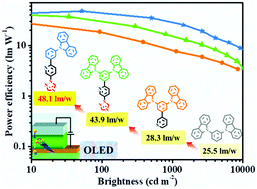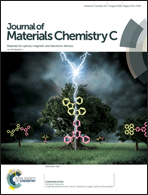Molecular evolution of host materials by regular tuning of n/p ratio for high-performance phosphorescent organic light-emitting diodes†
Abstract
By linking pyridine and 1,2,4-triazole as an electron-deficient group, two “dual n-type unit” bipolar host materials, namely 2-(3,5-di(9H-carbazol-9-yl)phenyl)-5-(1H-triazol-1-yl)pyridine (PyTzDCz) and 2-(3-(9H-carbazol-9-yl)phenyl)-5-(1H-triazol-1-yl)pyridine (PyTzSCz), and one bipolar reference compound 2-(3,5-di(9H-carbazol-9-yl)phenyl)pyridine (PyDCz) were designed and synthesized for use in phosphorescent organic light-emitting diodes (PhOLEDs). From the parent 1,3-bis(9H-carbazol-9-yl)benzene (mCP) via PyDCz and PyTzDCz to PyTzSCz, the molar ratio of n-type pyridine/triazole to p-type carbazole was regularly tuned as 0 : 2, 1 : 2, 2 : 2, and 2 : 1. With a regular increase of n/p ratio from 0 : 2 gradually to 2 : 1, the LUMO levels of these hosts are regularly deepened to enhance electron injection, and the turn-on voltages of their blue and green PhOLEDs are regularly decreased. Particularly, the PyTzSCz-hosted blue PhOLED turned on at 2.6 V with high power efficiency of 48.1 lm W−1 (corresponding to an external quantum efficiency of 26.4% and a current efficiency of 45.9 cd A−1), which is the lowest turn-on voltage so far and one of the highest power efficiencies reported for FIrpic PhOLEDs containing a single host. The PyTzSCz-hosted green device also exhibited low turn-on voltage of 2.4 V and high external quantum efficiency of 28.0%. This study manifests the molecular evolution trend of host materials from hole-transporting via bipolar to “dual n-type unit bipolar” for performance optimization.



 Please wait while we load your content...
Please wait while we load your content...